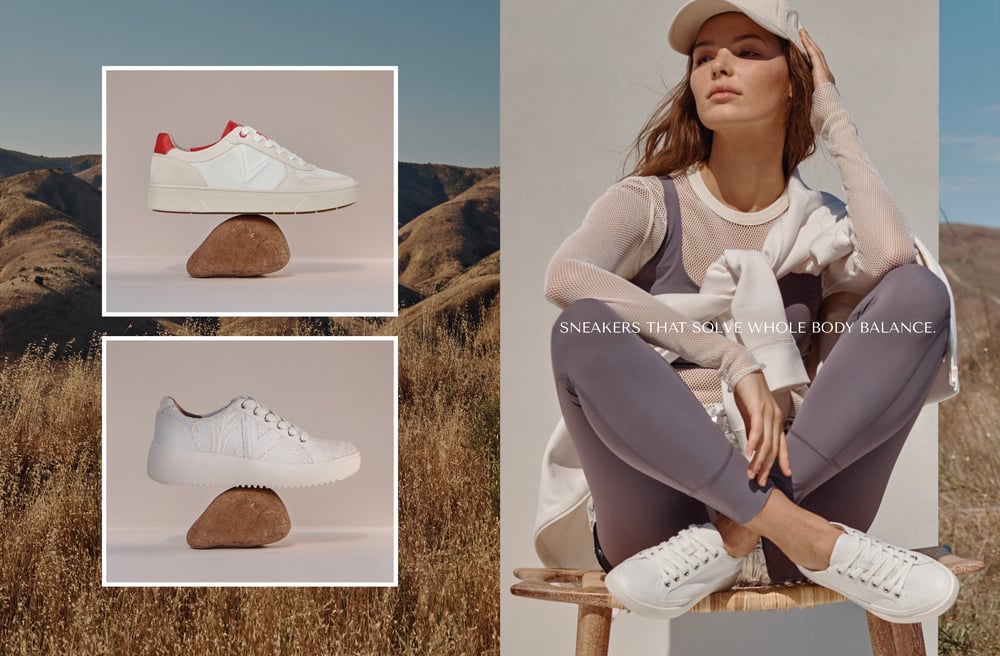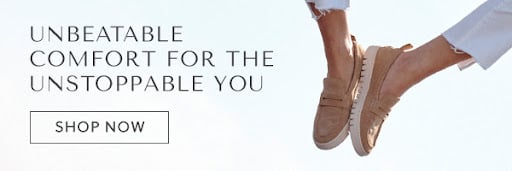
For many, the term court shoes conjures up images of tennis serves, volleyball digs, and pickleball returns. While you will find court shoes in these and similar sporty settings, they’re not only your perfect partner for a quick rally, but likewise pair beautifully with a variety of everyday outfits.
From dresses to business casual blazers, rompers, tracksuits, and more, court shoes match almost any aesthetic and keep your feet comfortable while doing so. But, what are court shoes, really, and what role can they play in your wardrobe?
Let’s volley through the complexities of court shoes to determine how they took their modern form, their different variations, and when to wear them. Then, we’ll discuss how to select the perfect pair of women’s casual sneakers for everyday use that will not only offer supreme support, but complete any fashionable look you can dream up.
How Did the Court Shoe Come to Be?
The first pieces of footwear called court shoes looked nothing like how we imagine them today. In fact, the type of court they were referring to isn’t even the same kind referenced by modern models. While contemporary court shoes are designed for a tennis court and other fast-paced sports in mind, in the late 18th century they were named for legal and royal courts, rather than places of recreation.
Thus, instead of being an athletic shoe, they were generally:
- Formal
- Made from black, patent leather
- Secured in place with straps and buckles, rather than laces
- High-heeled
Despite this early use of the term not being sports-related, tennis had already been a popular game in France and beyond for hundreds of years. It wasn’t until 1874, however, that the first official rule set for Lawn Tennis (the standardized game we play today) was created. This was a pivotal moment in court shoe history and, even though footwear was still mostly flat, leather, and not optimized for sports purposes, that would all soon change.
Court shoes really came to life with the invention of vulcanized rubber. The first rubber-soled shoe was created by the Liverpool Rubber Company in the early 19th century—but these were still a far cry from the court shoes we wear today.
Soon, however, multiple brands started hopping on the rubber athletic shoe train and produced soles out of the new material. It wasn’t until 1931, however, that the first piece of footwear marketed as a tennis court shoe hit the store shelves. Ever since then, designers have been building and improving on the style to optimize comfort and performance on and off the tennis court.
What Makes a Modern Court Shoe?
While court shoes can be worn for a variety of occasions, they’re purposely designed for optimal performance during, as their name suggests, court-based sports. More specifically, these tennis shoes are built to help up your game during:
- Tennis
- Basketball
- Racquetball
- Badminton
- Squash
- Volleyball
- Pickleball
- Similar activities
All of these sports require rapid bursts of running, stop and start motions, and quick turns and pivots to play properly. This fast-paced, lateral movement can cause your feet to slip around inside of your footwear—potentially resulting in ankle sprains, ligament tears, or pulled muscles. Luckily, court shoes are created specifically to prevent these kinds of injuries.
To ensure your feet stay securely fastened in place, court shoes are designed with a variety of safeguards. Style varies between brands and models but, in general, you’ll know it’s a court shoe if it has:
- A mid to high-cut – While other kinds of athletic shoes and comfortable sneakers for women end just below the ankle (i.e. are low-cut), court shoes feature, at the very least, a mid-cut design. A higher cut that extends above your ankle bone helps keep it more stable—preventing ankle sprains, rolls, and other potential injuries.
- Thick, heavy uppers – The uppers, or tops of your shoes, keep your feet locked to their soles and prevent you from coming out of your kicks entirely. The thick uppers on court shoes are there for the same reason as their higher cuts—to keep your foot as firmly planted as possible and prevent rolling. Oftentimes, they’ll also be manufactured with an extra layer of material over the toe cap as this spot tends to wear significantly during tennis serves.
- An extended outsole or midsole – This extra bit of material rises up the side walls of your court shoes to offer extra strength to the area where the soles and uppers meet. Outsoles and midsoles are also usually made of a non-marking rubber composite that provides added traction and prevents you from scuffing up the court’s floors.
- Firmer, thinner soles than other athletic footwear – Court shoes utilize thinner, harder soles as the firmness provides added stability during lateral movement. Firmer soles won’t warp as much from the downward pressure of our steps. When shoes deform, they tend to tilt to one side and throw off the natural pattern of your movements. This increases the chances of missteps and, in turn, injury. Likewise, thinner soles put you closer to the ground, reducing the possibilities of pronation and supination (rolling).
- A low-profile tread pattern – Since court games are usually played under ideal conditions (in a dry, clean wooden, synthetic, or clay court area), you don’t have to worry about rain and other environmental factors causing you to slip. Consequently, court shoes are designed with shallower treads than other athletic footwear such as trail or training shoes. Likewise, they often boast a circular pattern under the toe area to allow for quick pivots during matches.
As you can tell, much of the material used to produce court shoes is thicker and denser than other varieties of athletic footwear. The extra material does tend to make them a slightly heavier shoe compared to other types of sports footwear—which, for many, can be more comfortable than less robust, lighter styles.
That doesn’t necessarily mean every court shoe is particularly heavy or, for that matter, that they even have all the features listed above. In fact, court shoes have been evolving in recent times and now come in a variety of styles that you wouldn’t necessarily strap into for a game of tennis.
Contemporary Court Shoe Variations
Many modern court shoe models are shifting away from formal and athletic designs to create more casual footwear for everyday use. These designs still retain the comfort, security, and support of athletic shoes but boast the fashion-forward style of slick, trendy streetwear. Two leading models that embody this style of court shoe perfectly are:
- The Kimmie Court Sneaker – The Kimmie combines the best of court and casual wear into an everyday shoe for an exceptional pair of women’s casual sneakers. With a durable upper available in leather or suede, a thicker sole than athletic court shoes, and a bio-mechanically engineered footbed for maximum comfort, The Kimmie is your constant for routine wear. Pair it with your favorite tennis shirt while chilling courtside, jeans and a t-shirt for a casual lunch with friends, or whatever else you’d normally wear on a day-to-day basis.
- The Lucas Court Lace Up Sneaker – Essential for a day on the job or night out with friends, The Lucas combines the timeless look of street and skate footwear with the performance of men’s casual sneakers. They boast a supremely supportive sole and padded collar to cushion your every step—whether it’s on the court, sidewalk, or dance floor. They even feature that characteristic circular tread pattern on the sole so you can pivot to return a serve or bust a move with full confidence.
If you’re going to get one pair of court shoes for everyday wear, make them The Kimmie or The Lucas. With durable soles, uppers, and stitching, they’ll be your enduring partner on and off the court while keeping your feet feeling as fresh as their crisp style helps you look.
Vionic’s Court Shoes are the Pinnacle of Comfort and Class
Whether you’re a frequent pickleballer, tennis fanatic, or squash sensation—or you just want to be fashionable while feeling comfortable—Vionic has the perfect court shoes for you.
Every pair of Vionics is designed with our exclusive Vio Motion technology. These fabulous footbeds cradle your arches to provide optimal support and careful cushioning with every footfall. They’re also highly flexible while still offering supreme stability for your ankles. The result? A shoe you could wear all day without the fear of foot and ankle pain.
Whether you’re a tennis player or not, the right tennis shoe will provide you with the right cushioning and arch support for all your favorite activities. Shop Vionic to find your partner for playing sports, spectating, or simply living your everyday life.
Sources:
The Metropolitan Museum of Art. Court shoes. https://www.metmuseum.org/.
Satra. The development of the tennis shoe. https://www.satra.com/.
Foot & Ankle Specialists, PC. Design in Running, Court, and Fitness Shoes. https://monpod.com/.


Leave a Reply